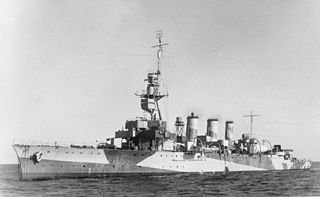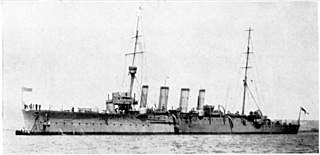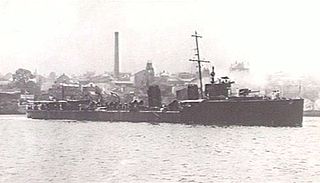Three ships and a naval base of the Royal Australian Navy have been named HMAS Brisbane after Brisbane, the capital city of Queensland.

HMAS Adelaide was a Town-class light cruiser of the Royal Australian Navy (RAN), named after Adelaide, the capital city of South Australia. Laid down in 1915, wartime shortages and design modifications meant the ship was not completed until 1922, earning her the nickname "HMAS Longdelayed".
Three ships of the Royal Australian Navy have been named HMAS Canberra, for Canberra, the capital city of Australia.
Three ships of the Royal Australian Navy (RAN) have been named HMAS Swan, for the Swan River in Western Australia.
Two ships of the Royal Australian Navy (RAN) have been named HMAS Australia. A third ship was to receive the name, but her transfer from the Royal Navy to the Royal Australian Navy was cancelled:

HMAS Pioneer was a Pelorus-class protected cruiser built for the Royal Navy at the end of the 19th century. She was transferred to the fledgling Royal Australian Navy (RAN) in 1912. During World War I, the cruiser captured two German merchant ships, and was involved in the East African Campaign, including the blockade of the cruiser SMS Königsberg and a bombardment of Dar-es-Salaam. She returned to Australia in late 1916 and was decommissioned. Pioneer was used as an accommodation ship for the following six years, then was stripped down and sold off by 1926. The cruiser was scuttled outside Sydney Heads in 1931.

The Leander class was a class of eight light cruisers built for the Royal Navy in the early 1930s that saw service in World War II. They were named after mythological figures, and all ships were commissioned between 1933 and 1936. The three ships of the second group were sold to the Royal Australian Navy (RAN) before World War II and renamed after Australian cities.

HMAS Stuart was a British Scott-class flotilla leader. The ship was built by Hawthorn Leslie and Company for the Royal Navy during World War I, and entered service at the end of 1918. The majority of the destroyer's British service was performed in the Mediterranean, and in 1933 she was transferred to the Royal Australian Navy. Although placed in reserve in 1938, Stuart was reactivated at the start of World War II to lead the Australian destroyer force, nicknamed the "Scrap Iron Flotilla" by German propagandists.

HMAS Sydney was a Chatham-class light cruiser of the Royal Australian Navy (RAN). Laid down in 1911 and launched in 1912, the cruiser was commissioned into the RAN in 1913.

HMAS Sydney, named after the Australian city of Sydney, was one of three modified Leander-class light cruisers operated by the Royal Australian Navy (RAN). Ordered for the Royal Navy as HMS Phaeton, the cruiser was purchased by the Australian government and renamed prior to her 1934 launch.

HMAS Brisbane was a Town class light cruiser of the Royal Australian Navy (RAN). Built in Sydney between 1913 and 1916 to the Chatham subtype design, Brisbane operated in the Indian Ocean, Pacific Ocean, and Australian coastal waters during World War I.

HMAS Melbourne was a Town class light cruiser operated by the Royal Australian Navy (RAN). The ship was laid down by Cammell Laird at Birkenhead in England in 1911, launched in 1912 and commissioned in 1913. At the start of World War I, Melbourne was involved in attempts to locate the German East Asia Squadron, and participated in the capture of German colonies in the Pacific, before being assigned to the North America and West Indies Stations. In 1916, the cruiser joined the Grand Fleet in the North Sea, where she remained for the remainder of the war. Melbourne spent late 1919 and early 1920 in reserve, then was flagship of the Royal Australian Navy from 1920 until 1928, except for a second period in reserve during 1924 and 1925. HMAS Melbourne paid off in the United Kingdom on 23 April 1928, and was scrapped in 1929.

HMAS Norman (G49/D16) was an N-class destroyer operated by the Royal Australian Navy (RAN) during World War II. Entering service in 1941, the ship was on loan from the Royal Navy.

The Battle of Cocos was a single-ship action that occurred on 9 November 1914, after the Australian light cruiser HMAS Sydney, under the command of John Glossop, responded to an attack on a communications station at Direction Island by the German light cruiser SMS Emden, commanded by Karl von Müller.

On 19 November 1941, the Australian light cruiser HMAS Sydney and the German auxiliary cruiser Kormoran engaged each other in a battle off the coast of Western Australia. Sydney, with Captain Joseph Burnett commanding, and Kormoran, under Fregattenkapitän Theodor Detmers, encountered each other approximately 106 nautical miles off Dirk Hartog Island. The single-ship action lasted half an hour, and both ships were destroyed.

HMAS Huon (D50), named after the Huon River, was a River-class torpedo-boat destroyer of the Royal Australian Navy (RAN). Originally to be named after the River Derwent, the ship was renamed before her 1914 launch because of a naming conflict with a Royal Navy vessel.

The history of the Royal Australian Navy traces the development of the Royal Australian Navy (RAN) from the colonisation of Australia by the British in 1788. Until 1859, vessels of the Royal Navy made frequent trips to the new colonies. In 1859, the Australia Squadron was formed as a separate squadron and remained in Australia until 1913. Until Federation, five of the six Australian colonies operated their own colonial naval force, which formed on 1 March 1901 the Australian Navy's (AN) Commonwealth Naval Force which received Royal patronage in July 1911 and was from that time referred to as Royal Australian Navy (RAN). On 4 October 1913 the new replacement fleet for the foundation fleet of 1901 steamed through Sydney Heads for the first time.

Theodor Detmers was a German naval officer and captain of the German auxiliary cruiser Kormoran during World War II. He was a recipient of the Knight's Cross of the Iron Cross of Nazi Germany. Detmers commanded the commerce raider Kormoran when it sunk the Australian light cruiser HMAS Sydney in a mutually destructive battle.

Ships and units of the Royal Australian Navy have received numerous battle honours throughout the navy's history.















